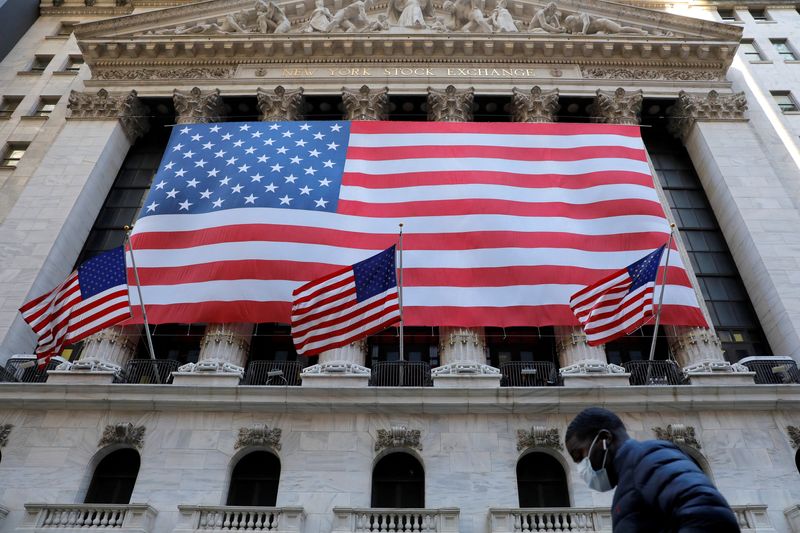(Reuters) - Shaky U.S. stock markets may get another curveball in the form of U.S. inflation data while on the other side of the pond, markets wait to see if British Prime Minister Boris Johnson manages to shore up support after a string of scandals.
In China, the Winter Olympics are getting underway with a display of close ties between Moscow and Beijing.
Here's your week-ahead in markets from Lewis Krauskopf in New York, Vidya Ranganathan in Singapore, Swati Bhat in New Delhi and Dhara Ranasinghe and Karin Strohecker in London.
1/PRICE POINT
Fears of a hawkish Federal Reserve brought a tumultuous start of 2022 for U.S. stocks - inflation data on Thursday could show is the concerns are fully justified.
January's U.S. consumer price index is expected to rise 0.4%, a Reuters poll shows. That's after 0.5% in December, culminating in the largest annual rise in nearly four decades.
Given that Fed Chair Jerome Powell has pledged a sustained battle to tame inflation, the U.S. central bank seems on course to hike interest rates in March. Analysts are upping rate calls; BofA for instance expects seven 25 basis points hikes this year.
How inflation is hitting corporate America's bottom line will be in focus too, as more fourth-quarter reports roll in, including from Coca-Cola (NYSE:KO) and Pfizer (NYSE:PFE). GRAPHIC: U.S. consumer price inflation, https://fingfx.thomsonreuters.com/gfx/mkt/akpeznoqdvr/Pasted%20image%201643844981321.png
2/ HOT HOT HOT
The Bank of England now reckons Britain's inflation rate could top 7%, well above previous forecasts. No wonder nearly half of its policymakers wanted a bigger increase than the 25 bps hike they agreed on.
With a cost of living crisis a political issue, the government has set out a series of financial support schemes to take the sting out of rising energy prices.
December industrial production data and a Q4 GDP estimate on Friday should provide a sense of how the economy is holding up.
Complicating the picture is a political crisis. Prime Minister Boris Johnson faces anger over a series of missteps, not least the alcohol-fuelled parties held at Downing Street during coronavirus lockdowns. The coming days could bring more clarity on his future. GRAPHIC: UK consumer confidence at its lowest since Feb 2021, https://fingfx.thomsonreuters.com/gfx/mkt/zdvxoaxwjpx/GBTHEME.PNG
3/ "STREAMLINED, SAFE AND SPLENDID"
That's Chinese President Xi Jinping's promise for the Beijing Olympics. He could well have been referring to the yuan, this year's lone currency outperformer against a buoyant dollar.
As China returns from a week-long Lunar New Year break, markets want to know if that outperformance can continue in the face of a growing monetary divergence between the world's top two economies. January was the strongest month for the yuan since 2017, but Chinese New Year often heralds a reversal.
Yet other factors are at play: elevated commodity prices, curbs to contain Omicron and heavy foreign inflows into domestic bonds - all positive for China's trade surplus. And Russian President Vladimir Putin is in China for the Olympics, signing more than 15 agreements with Beijing. Both countries are keen on joint financial infrastructure to guard against sanctions from other countries. That probably calls for a strong yuan. GRAPHIC: China export growth robust, yuan firm, https://fingfx.thomsonreuters.com/gfx/mkt/myvmnnxzzpr/20210827-exportsyuan.png
4/INDIAN DOVES TO DUCK OUT?
India's inflation-targeting monetary policy committee has reiterated time and again it will remain supportive of growth until economic recovery is firmly entrenched. But the recent budget may force a rethink.
Sticky inflation and improving confidence on the growth outlook may set the stage for the key lending rate to rise in the coming fiscal year.
The Reserve Bank of India may kick off changes at its Wednesday, possibly by raising its borrowing rate in order to shrink the corridor with the lending rate. Investors will also listen out for the RBI's views on the budget and how it might help markets absorb a record 14.95 trillion rupees ($200 billion) in borrowing. GRAPHIC: Retail inflation since India's Modi came to power, https://graphics.reuters.com/INDIA-INFLATION/INDIA/zdpxoqmqyvx/chart.png
5/ STICKY OIL
After a month of simmering geopolitical tensions and a 15% oil price surge, OPEC and its allies took a record-quick 16 minutes to decide that, after all, they would stick to previously planned output increases.

Crude prices are around seven-year highs of more than $90 a barrel due to fear of supply disruptions from a multitude of geopolitical flare-ups, above all, a possible Russia-Ukraine conflict. Europe is scrambling to find alternatives to Russian gas, while U.S. winter storms, at a time of general underproduction are an added problem.
Energy prices also risks turning into a political hot potato for governments. Having already contributed to record-high inflation, further price gains risk slowing growth momentum. GRAPHIC: Brent crude on a tear, https://fingfx.thomsonreuters.com/gfx/mkt/xmvjojbbopr/Brent%20crude%20on%20a%20tear.PNG
